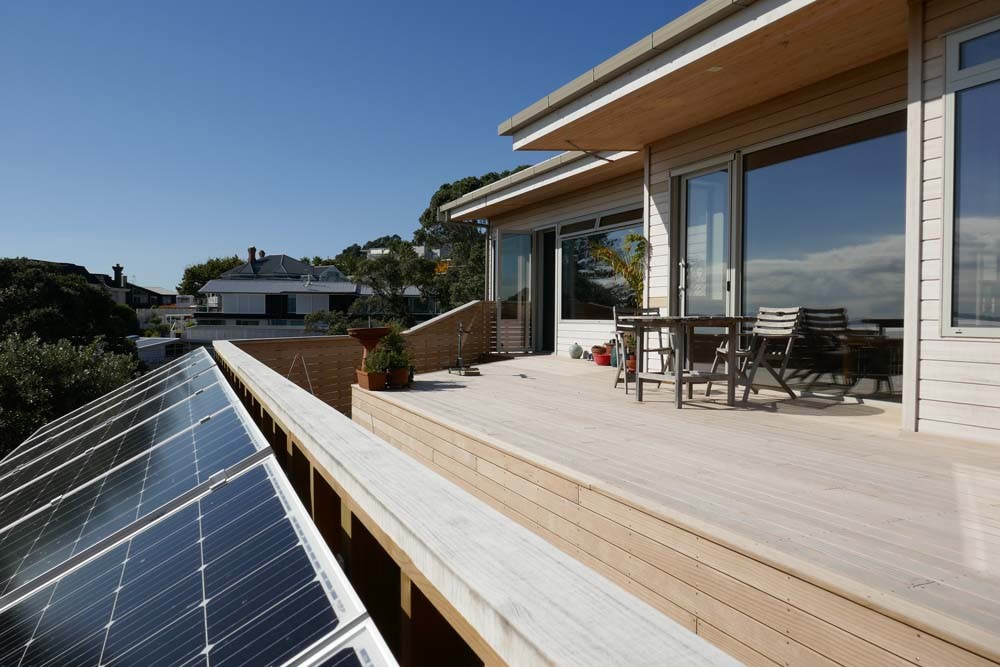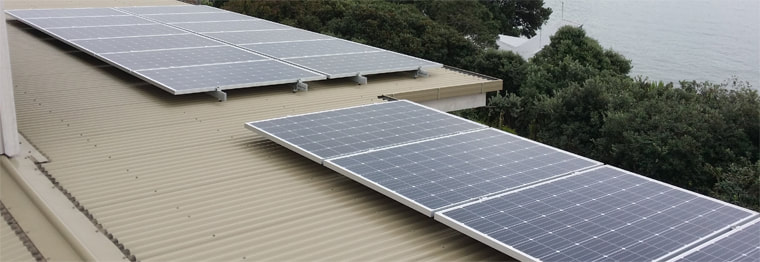A full grid connected solar PV system
(report provided by owner, Jon Brett)
(report provided by owner, Jon Brett)
Justification for Solar
|
Of course, we will save money on our power bills and can survive power cuts day or night thanks to a battery. Most people write off solar power when they try to balance the cost of installation with the reduction in cost of using power. The Tanglewood rationale was totally different. We didn't expect to get a cost saving for building a carport and putting in a driveway (instead of parking on the street). We did expect to generate way more energy than we need, even in winter, and even enough for the use of an electric vehicle.
|
We need to stay connected to the grid, so we can export our energy. So even though we buy electricity at 27c/kWh but get paid only 8c/kWh, we will be regenerating some of the energy used in creating the solar system, the house, the car, the driveway.
Regeneration is climate action: an obligation, not an option
The cost of embodied energy is often overlooked. A common misconception is that the kWh we receive over the power lines is the main cost of the electricity for the power companies. Actually that cost is trivial compared with the cost of building and maintaining the power generation and distribution systems.
How many panels?
If you know your energy budget – how much power you normally use over a year – it is easy to calculate how many panels you need to generate that. However, the inconvenient truth is that everyone needs MORE power in the winter when there is LESS sun, at a much lower angle. Tanglewood was also complicated by another inconvenient truth that although it faces due north, our view is also due north, and we prefer to look at the view, not the backs of solar panels. Plus, we need easy access to wash the panels and remove sea salt, and seagull and bee poo.
18 panels fit on the lower roof but have to lie flat to the 8 degree pitch so the upper floor can look over them. It would have been way too dangerous to clean panels on the upper floor roof. However, the upper floor provides easy access onto the lower floor roof, and an exterior tap for easy hosing down the panels.
Another 9 panels hang off the front of the lower floor deck balustrade, and can be manually adjusted for winter or summer sun. The key to this is a 1.2m wide walkway around the outer edge of the deck, lowered half a metre below main deck level and enabling us to sit on the deck and still see over the balustrade. For May, June and July we angle the panels at 55 degrees, and set them to 30 degrees for the rest of the year. NIWA Solarview calculates that our 55 degree panels give us 29% more energy than our 8 degree panels in June when we need it most. In other words, our 9 steep panels are doing more work than 11 of our flat panels.
Link for NIWA Solarview: https://www.niwa.co.nz/our-services/online-services/solarview
Another 9 panels hang off the front of the lower floor deck balustrade, and can be manually adjusted for winter or summer sun. The key to this is a 1.2m wide walkway around the outer edge of the deck, lowered half a metre below main deck level and enabling us to sit on the deck and still see over the balustrade. For May, June and July we angle the panels at 55 degrees, and set them to 30 degrees for the rest of the year. NIWA Solarview calculates that our 55 degree panels give us 29% more energy than our 8 degree panels in June when we need it most. In other words, our 9 steep panels are doing more work than 11 of our flat panels.
Link for NIWA Solarview: https://www.niwa.co.nz/our-services/online-services/solarview
Why bother with a battery?
Generating energy is only half the story. The other half is reducing the energy used, and storing the energy for when it is needed. The beauty of our Tesla battery is that it comes with an excellent app that illustrates the flow of energy between the house, solar, battery and grid. The grid creates the illusion that energy is always available at a similar cost no matter the weather, even though we know it affects the cost to the provider. The battery provides a fixed budget that we can try and live within, requiring us to modify our behaviour when the sun doesn't shine. Fortunately in Auckland, that is not often, but we can easily adjust when we use the dishwasher, laundry, take a shower, or recharge the car.
Our expectation for the battery was that we should get equivalent to one normal day's worth of energy storage to begin with, and that as batteries become cheaper, we add more later. The Tesla battery can be located inside, but we installed it under the house as its fan does make some noise, and the inverter which needs to be installed nearby is also a little noisy. Interestingly, Tesla want internet access to the battery and reduce the warranty from 10 to 4 years if it is not available. This all helps them to improve technology from experience.
Our expectation for the battery was that we should get equivalent to one normal day's worth of energy storage to begin with, and that as batteries become cheaper, we add more later. The Tesla battery can be located inside, but we installed it under the house as its fan does make some noise, and the inverter which needs to be installed nearby is also a little noisy. Interestingly, Tesla want internet access to the battery and reduce the warranty from 10 to 4 years if it is not available. This all helps them to improve technology from experience.
|
© 2016 - Equinox Design Ltd - All Rights Reserved
|

